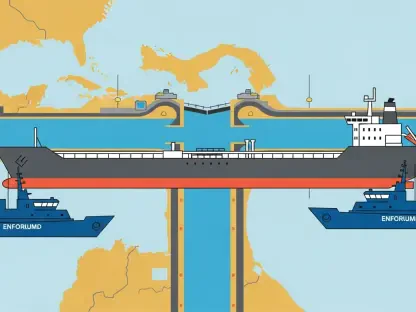In a bold move that could reshape the nation’s energy landscape, the Trump administration has unveiled plans to auction off nearly 80 million acres of federal waters in the Gulf of Mexico for oil and gas drilling, marking one of the largest offerings in recent history. This staggering figure, part of a single lease sale, underscores a relentless drive toward fossil fuel dominance. As energy debates heat up across the country, this initiative raises critical questions about the balance between economic growth and environmental impact. What lies beneath this aggressive push for offshore drilling, and how will it redefine America’s future?
Why Offshore Drilling Captures National Attention
The spotlight on offshore drilling has intensified with the administration’s announcement of a historic auction in the Gulf of Mexico, often dubbed the “Gulf of America” by President Trump. This sale, encompassing an area larger than many U.S. states, signals a dramatic shift in energy policy, prioritizing fossil fuel extraction on an unprecedented scale. The urgency stems from a perceived need to secure domestic resources amid global market volatility, thrusting the issue into public and political discourse.
Beyond the sheer size of the auction, the timing aligns with a broader narrative of reducing reliance on foreign oil. Policymakers argue that unlocking these vast underwater reserves could bolster energy security at a time when international tensions threaten supply chains. This move has sparked heated discussions, with supporters and critics alike debating the long-term implications of such a massive commitment to non-renewable energy sources.
The scale of this policy shift cannot be overstated, as it represents a deliberate pivot away from renewable energy incentives. With the government setting its sights on decades of drilling, the focus on offshore resources has become a lightning rod for conversations about America’s economic priorities and its role in the global energy market. This development demands attention as it unfolds.
The Critical Role of Offshore Drilling in Energy Strategy
Energy independence stands as a central pillar of the Trump administration’s agenda, with offshore drilling positioned as a key mechanism to achieve it. By tapping into the untapped potential of federal waters, the goal is to flood the market with domestically sourced oil and gas, potentially stabilizing prices for consumers. This strategy is seen as a direct response to fluctuating global energy costs that have strained household budgets and industrial sectors alike.
Drilling in regions like the Gulf of Mexico and Alaska’s Cook Inlet also ties into larger geopolitical concerns. Reducing dependence on imports from volatile regions is framed as a matter of national security, ensuring that the nation can weather disruptions without crippling shortages. Additionally, the administration highlights the potential for job creation, estimating thousands of positions in drilling, logistics, and related industries as a direct economic benefit.
This approach, however, is not without its complexities. While the promise of energy self-sufficiency resonates with many, it also raises questions about sustainability in an era of growing climate concerns. The emphasis on offshore drilling as a cornerstone of economic policy underscores a commitment to fossil fuels that could shape energy infrastructure for generations, making it a pivotal issue in today’s landscape.
Unpacking the Administration’s Offshore Drilling Plan
The Trump administration’s blueprint for expanding offshore oil and gas production is both ambitious and meticulously detailed. At its core is a landmark lease sale in the Gulf of Mexico, offering approximately 80 million acres for exploration and extraction, with the first auction scheduled for December 10. This is just the beginning, as a tax law mandates 30 such sales in the region through 2040, ensuring a steady pipeline of drilling opportunities.
Parallel to this, a significant proposal targets Alaska’s Cook Inlet, where about 1 million acres are slated for auction starting March 4 next year. This marks the initial step in a series of at least six annual sales planned from 2026 to 2032, also backed by legislative mandates. To sweeten the deal for industry players, a minimal royalty rate of 12.5% has been set for both shallow and deepwater leases across these areas, a clear incentive to attract major oil companies.
These initiatives reveal a calculated effort to maximize domestic output over the long haul. The structured leasing schedules provide predictability for investors, while the vast acreages offered signal an all-in approach to fossil fuel development. This comprehensive strategy aims to cement the United States as a leading energy producer, reshaping the industry’s trajectory for decades.
Insights from Experts and Key Figures
Voices from within the administration paint a picture of unwavering commitment to this offshore expansion. Matt Giacona, acting director of the Bureau of Ocean Energy Management (BOEM), has emphasized the importance of these lease sales, stating they establish “a predictable, long-term leasing schedule” vital for sustained offshore development. Such statements reflect a firm belief in the economic necessity of bolstering fossil fuel production.
Industry stakeholders have also weighed in, with many oil and gas executives expressing enthusiasm for the low royalty rates and expansive opportunities. A representative from a major energy firm noted that the reduced financial barriers could spur significant investment, potentially accelerating projects that might otherwise have stalled. This perspective highlights the policy’s appeal to corporate interests eager to capitalize on accessible federal waters.
Local reactions, particularly from communities near drilling zones, add another layer to the conversation. While some welcome the promise of jobs and economic boosts, others voice apprehension about environmental risks and disruptions to coastal livelihoods. These diverse viewpoints underscore the multifaceted impact of the administration’s plans, illustrating a policy that is as polarizing as it is transformative.
Navigating the Offshore Drilling Landscape as a Stakeholder
For businesses, residents, and concerned citizens, engaging with this sweeping energy shift requires a proactive approach. Keeping abreast of upcoming lease sales, such as the major auction in the Gulf of Mexico this December, is a critical first step. The BOEM regularly publishes updates and schedules, providing a resource for tracking developments and understanding the scope of planned drilling activities.
Beyond staying informed, there are opportunities to influence the process through public comment periods and local forums hosted by federal agencies. These platforms allow individuals and organizations to express support or raise concerns about specific sales, ensuring that diverse perspectives are considered. For those in drilling-adjacent regions, assessing potential economic benefits—like job growth in support industries—can also guide informed decision-making.
Equally important is monitoring regulatory changes that might accompany these initiatives. As policies evolve, they could impact everything from environmental protections to royalty structures, affecting both industry players and local ecosystems. By actively participating in this dialogue, stakeholders can help shape an energy future that balances growth with responsibility, ensuring their voices are heard amid rapid policy shifts.
Reflecting on a Defining Energy Chapter
Looking back, the Trump administration’s push to expand offshore drilling stood as a defining moment in America’s energy saga. The audacious scale of lease sales in the Gulf of Mexico and Alaska’s Cook Inlet marked a resolute commitment to fossil fuel dominance, prioritizing economic gains and energy security over alternative paths. This era reshaped the national conversation around resource extraction, leaving an indelible mark on policy and industry alike.
As history moved forward, the challenge became finding equilibrium between immediate benefits and long-term consequences. Stakeholders were encouraged to delve deeper into regulatory updates and community impacts, ensuring that future decisions reflected a broader understanding of the stakes. Engaging with federal agencies and local initiatives offered a pathway to influence outcomes, fostering a more inclusive dialogue.
Ultimately, the legacy of these policies prompted a critical reflection on how energy choices ripple through generations. The call remained clear: to stay vigilant, advocate for balanced approaches, and explore innovations that could harmonize economic needs with environmental stewardship. This chapter, though closed, opened doors to ongoing debates and actions that would define the nation’s energy horizon.









